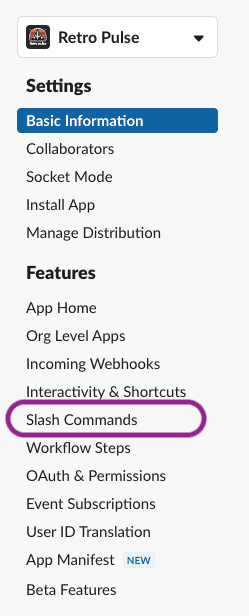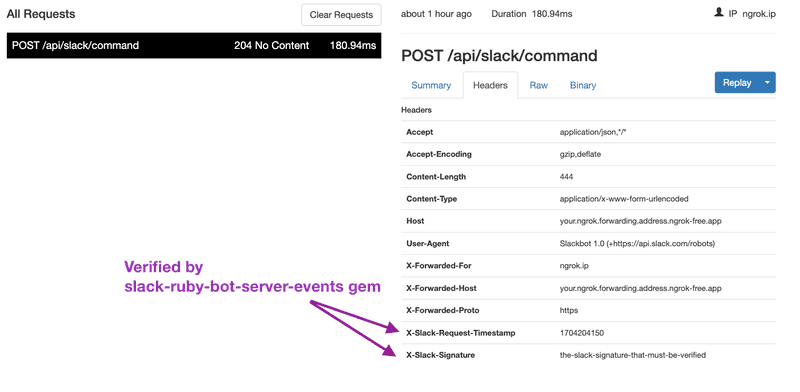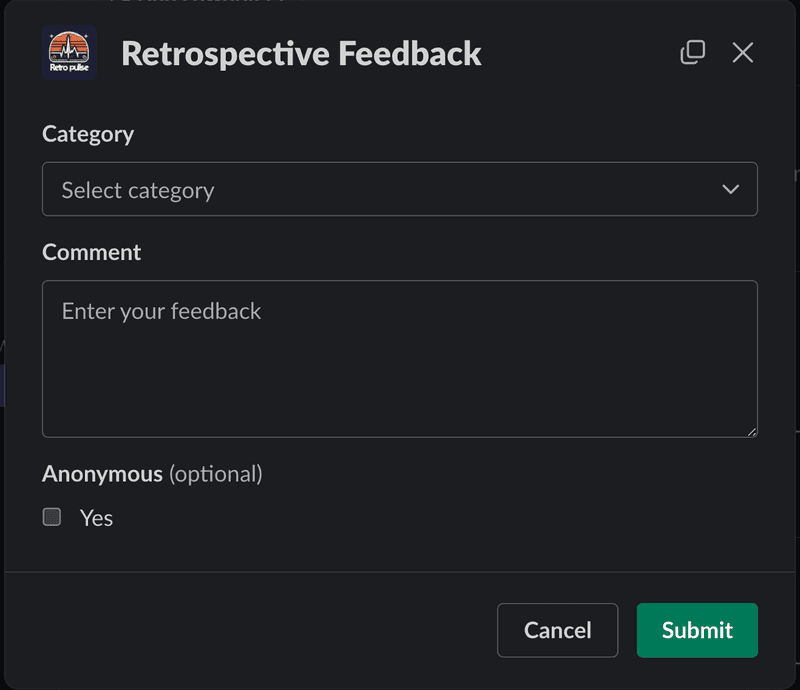Build a Rails App with Slack Part 2: Slash Command with Text Response

Welcome to the second installment of this multi-part series on building a Slack application with Rails. This series will guide you through the process of creating a Slack application with Rails and is structured as follows:
- Part 1: Rails new, Slack, and OAuth
- Part 2: Slack Slash Command with Text Response === YOU ARE HERE ===
- Part 3: Slack Slash Command with Modal Response
- Part 4: Slack Action Modal Submission
- Part 5: Slack Slash Command with Block Kit Response
Feel free to jump to a specific part of interest using the links above or follow along sequentially. You can also checkout the source code on Github for the application we'll be building.
This post assumes the reader has at least a beginner level familiarity with Ruby on Rails. It's also assumed the reader has used Slack as an end user with basic interactions such as joining channels, sending messages, and participating in conversations.
Part 1 of this series introduced Retro Pulse, a Slack app built with Rails for agile teams to manage their retrospectives with Slack. Part 2 (this post) will explain how to implement the Slack slash command to open a retrospective and return a markdown text response to the same Slack channel that initiated the request, confirming the retrospective has been opened.
The interaction proceeds as follows:
In a Slack workspace with the Retro Pulse app installed (installation was covered in Part 1), a user can enter a slash command /retro-open, followed by a project name:

After hitting Enter, the app responds with a confirmation that the retrospective has been opened:

In the Rails console bin/rails c of the Rails application backing the Slack app, the Retrospective has been created:
Retrospective.last
# Retrospective Load (1.1ms) SELECT "retrospectives".* FROM "retrospectives" ORDER BY "retrospectives"."id" DESC LIMIT $1 [["LIMIT", 1]]
# <Retrospective:
# id: 31,
# title: "Quantum Canvas Sprint 3",
# created_at: ...,
# updated_at: ...,
# status: "open">Create Slash Command in Slack
The first step in implementing this is to navigate to Your Apps on Slack, select the "Retro Pulse" app you created in Part 1 of this series, and then select "Slash Commands" from the Features section:

Then click on the "Create New Command" button, and fill in the form as follows:
Command: /retro-open. This is what the user will type into a Slack message to initiate an interaction with the Retro Pulse Rails app.
Request URL: For example: https://12e4-203-0-113-42.ngrok-free.app/api/slack/command. This is where Slack will send an HTTP POST request when the user submits this slash command from Slack. The hostname is your ngrok forwarding address that you got from starting ngrok in part 1 of this series. The route /api/slack/command is defined in the slack-ruby-bot-server gem that we included as part of our Rails app in part 1 of this series.
Short Description: Open a new retrospective for comments. This will be displayed as the user types in the slash command.
Usage Hint: title. Since this particular slash command requires a parameter, which will be used to create the retrospective, the usage hint is also shown to the user as they type in the slash command.
Escape Channels: Leave this unchecked. Turning this on will modify the parameters sent with a command by a user such as wrapping URLs in angle brackets and translating channel or user mentions into their correlated IDs. It's not necessary for this app. See the Slack documentation if your app needs this option.
The filled out form will look something like this:

Click the "Save" button, which at the time of this writing, appears all the way at the bottom right-hand corner of the screen.
Receive Slash Command in Rails
The next step is to update the Rails app to handle the HTTP POST to /api/slack/command that Slack will send whenever a user submits the /retro-pulse something Slash command. Recall that we're using the slack-ruby-bot-server-events gem, which takes care of a lot of the boilerplate including providing a controller to parse the body, and logic to verify the X-Slack-Signature HTTP header.
Start by creating a bot directory in the root of the Rails project as shown below. The bot directory is a sibling to the Rails app directory:
# from root of Rails project
mkdir bot
touch bot/slash_commands.rb
mkdir bot/slash_commands
touch bot/slash_commands/retro_open.rbYou should have the following structure:
.
├── app
└── bot
├── slash_commands
│ └── retro_open.rb
└── slash_commands.rbAdd the following in bot/slash_commands.rb to load all the slash commands, there's only one for now:
# bot/slash_commands.rb
require_relative "slash_commands/retro_open"Fill in the implementation for the retro open command handler. For now, it will only log out the text it received, as well as the team name and Slack channel ID the command was called from. The team will be fetched by the team_id that is available from the command object exposed by the slack-ruby-bot-server-events gem. The channel_id and text are also available from the command object. The Team model got populated in Part 1 of this series when we ran the OAuth flow to add this app to a Slack workspace.
# bot/slash_commands/retro_open.rb
SlackRubyBotServer::Events.configure do |config|
# Essentially this is saying to the SlackRubyBotServer,
# If a "/retro-open" slash command is received from Slack,
# then execute this block.
config.on :command, "/retro-open" do |command|
team = Team.find_by(team_id: command[:team_id])
channel_id = command[:channel_id]
# If user entered /retro-open foo
# in Slack, then command_text will be: foo
command_text = command[:text]
command.logger.info "=== COMMAND: retro-open, Team: #{team.name}, Channel: #{channel_id}, Title: #{command_text}"
# Return `nil`, otherwise the slack-ruby-bot-server-events gem
# replies to the channel with a message "true"
nil
end
endThen update config.ru file in the root of the Rails app to load the command handlers in the bot directory. This will ensure the the Slack bot code is loaded when Rails starts:
# This file is used by Rack-based servers to start the application.
require_relative "config/environment"
# === ADD THIS LINE TO LOAD THE SLASH COMMAND HANDLERS ===
require_relative "bot/slash_commands"
# We added this line previously in Part 1 of this series:
SlackRubyBotServer::App.instance.prepare!
run Rails.application
Rails.application.load_serverNow we're ready to see this in action. Start the Rails server with bin/dev. Then go to your Slack app, and enter the following in any channel:
# Enter whatever title text you want after the slash command
/retro-open My Project Sprint 1After hitting Enter in Slack to submit the slash command, the Rails server output will show that the HTTP POST to /api/slack/command has been received and processed. Notice it runs a SQL SELECT to find the team, this is as a result of Team.find_by(team_id: command[:team_id]) in the command handler:
Started POST "/api/slack/command"
Team Load (2.1ms) SELECT "teams".* FROM "teams"
WHERE "teams"."team_id" = $1 LIMIT $2
[["team_id", "the-team-id-from-slack"], ["LIMIT", 1]]
I, INFO -- : === COMMAND: retro-open,
Team: YourTeamName,
Channel: the-channel-from-slack,
Title: My Project Sprint 1The Title displayed in the logger INFO should match whatever you typed in as the text following /retro-open in Slack.
You may be wondering how it is that the code we wrote in bot/slash_commands/retro_open.rb is being executed when the HTTP POST is received. This is where the combined functionality of the slack-ruby-bot-server and slack-ruby-bot-server-events gems comes into play.
When we specified config.on in the SlackRubyBotServer::Events.configure block, this added the handler as a callback. Then, the endpoint provided by the slack-ruby-bot-server gem, which handles the HTTP POST for /api/slack/command, parses out the specific command name and executes all callbacks that are registered for that command. This integration between the two gems allows for the automatic execution of the appropriate code when Slack sends a request to our Rails application's endpoint.
Inspect Request
One thing that can seem a little "magical" at this point, is that we didn't write a Rails controller to handle the /api/slack/command HTTP Request. This is being handled by the slack-ruby-bot-server-events gem. Unlike Rails controllers that we write, it doesn't log out the parameters it was called with. However, we can still view the entire HTTP POST request and body using ngrok.
In the terminal tab where ngrok is running, it includes an address for the Web Interface:
ngrok http 3000
# Output will look something like this, your details will vary:
# Region United States (us)
# Latency 35ms
# Web Interface http://127.0.0.1:4040
# Forwarding https://12e4-203-0-113-42.ngrok-free.app -> http://localhost:3000Enter http://127.0.0.1:4040 in a browser. This will allow you to inspect all HTTP requests that were received by ngrok and the corresponding HTTP responses that were sent by the Rails app. At this point, you should have one request for POST /api/slack/command. It will look something like this. Your specific Slack details will vary:

This shows all the form parameters that Slack sent in the HTTP POST /api/slack/command. Notice these include team_id and channel_id. These get parsed out by the slack-ruby-bot-server-events gem and are available on the command object in the block of the slash command handler.
You can also view the HTTP headers. These include the X-Slack-Request-Timestamp and X-Slack-Signature headers that are verified by the slack-ruby-bot-server-events gem. If you weren't using a gem for this, you'd have to write this verification code yourself:

Implement Slash Command
Now that we can see the communication between Slack and Rails working, the /retro-open slash command handler can be enhanced to do the real work of opening a new retrospective, with the title populated from the slash command text.
In order to create a Retrospective, we need to first define a database table to persist retrospectives with migrations, and a Retrospective model. A retrospective must have a unique title (eg: "Some Project Sprint 3"), a status (either open or closed), and there should only be one open retrospective at a time.
Here is the migration to create a retrospectives table with a required and unique title:
class CreateRetrospectives < ActiveRecord::Migration[7.0]
def change
create_table :retrospectives do |t|
t.string :title, null: false
t.timestamps
end
add_index :retrospectives, :title, unique: true
end
endHere is the migration to add a status column to the retrospectives table, implemented as a PostgreSQL enum type to restrict it to only values open and closed:
class AddStatusToRetrospectives < ActiveRecord::Migration[7.0]
def up
execute <<-SQL.squish
CREATE TYPE retrospective_status AS ENUM ('open', 'closed');
SQL
add_column :retrospectives, :status, :retrospective_status, default: "open", null: false
end
def down
remove_column :retrospectives, :status
execute <<-SQL.squish
DROP TYPE retrospective_status;
SQL
end
endHere is the Retrospective model with schema annotations and validations:
# == Schema Information
#
# Table name: retrospectives
#
# id :bigint not null, primary key
# status :enum default("open"), not null
# title :string not null
# created_at :datetime not null
# updated_at :datetime not null
#
# Indexes
#
# index_retrospectives_on_title (title) UNIQUE
#
class Retrospective < ApplicationRecord
enum status: {
open: "open",
closed: "closed"
}
validates :title, presence: true, uniqueness: true
validates :status, presence: true
validate :only_one_open_retrospective
private
def only_one_open_retrospective
return unless open? && Retrospective.exists?(status: "open")
errors.add(:status, "There can only be one open retrospective at a time.")
end
endNow let's return our attention to the retro_open.rb slash command handler. After it has extracted the command text, which is to be the title of the retrospective, it needs to create a new retrospective. If the new retrospective can be successfully saved, then it should post a success message back to the channel from which it was called. Otherwise, it should post an error message.
To post messages to Slack, we'll use an instance of Slack::Web::Client, instantiating it with the team's token, that got persisted earlier in the OAuth flow. The Slack web client is provided from the slack-ruby-client gem that is included with this project. Note that emoji's and markdown can be included in the message sent back to Slack.
# bot/slash_commands/retro_open.rb
SlackRubyBotServer::Events.configure do |config|
# Essentially this is saying to the SlackRubyBotServer,
# If a "/retro-open" slash command is received from Slack,
# then execute this block.
config.on :command, "/retro-open" do |command|
# Use `command[:team_id]` from request parameters sent to us
# by Slack to find the Team model persisted in the database
team = Team.find_by(team_id: command[:team_id])
# This is the Slack channel we need to respond back to
channel_id = command[:channel_id]
# If user entered /retro-open foo
# in Slack, then command_text will be: foo
command_text = command[:text]
command.logger.info "=== COMMAND: retro-open, Team: #{team.name}, Channel: #{channel_id}, Title: #{command_text}"
# Instantiate a slack client with the team token
# so we can communicate back to the channel
slack_client = Slack::Web::Client.new(token: team.token)
# Create a new retrospective with title from Slack
# Status will default to `open`
retrospective = Retrospective.new(title: command_text)
# Try to save it
if retrospective.save
# If save worked, post a success message to the channel
slack_client.chat_postMessage(
channel: channel_id,
mrkdwn: true,
text: ":memo: Opened retro `#{retrospective.title}`"
)
else
# If save failed, post the error messages from the model
slack_client.chat_postMessage(
channel: channel_id,
mrkdwn: true,
text: ":warning: Could not create retro `#{command_text}`, error: #{retrospective.errors.full_messages}"
)
end
# Return `nil`, otherwise the slack-ruby-bot-server-events gem
# replies to the channel with a message "true"
nil
end
endRestart the Rails server bin/dev after making these changes. Now you should be able to enter something like /retro-open My Project Sprint 1 in the Slack workspace and have the app respond with a success message:

The Rails server output shows that a new record is inserted in the retrospectives table:
Retrospective Create (3.1ms) INSERT INTO "retrospectives"
("title", "created_at", "updated_at", "status")
VALUES ($1, $2, $3, $4) RETURNING "id"
[
["title", "My Project Sprint 1"],
["created_at", "2024-01-03 14:10:19.285310"],
["updated_at", "2024-01-03 14:10:19.285310"],
["status", "open"]
]If you try to open another retrospective, for example /retro-open My Project Sprint 2, then an error message should be posted back to Slack with an explanation of why the retrospective could not be created:

Refactor
While the retro_open.rb slash command handler works, there are some issues to consider:
- The code is getting long and difficult to read.
- It might be a good idea to sanitize the title text from the user before saving it to the database, although adding this will make the code even longer.
- There's some code duplication in the multiple calls to
slack_client.chat_postMessage(...)where the only thing that varies is the message text. - There's no way to test all this logic in an automated fashion, and this problem will compound over time as more requirements are added and the logic grows in complexity.
Comparing the command handler framework provided by the slack-ruby-bot-server-events gem to a Rails controller, what we have here is the same problem that can affect any Rails application: Where to put the business logic?
In the case of a Slack application, the command handlers can be thought of as a type of "Slack controller". We would like to have these only focused on extracting the necessary data from the Slack command, and then have the business logic live somewhere else, where it's easier to test.
There are a number of different options for organizing business logic in Rails applications:
- Leave it in the controller and test it with request (aka integration) tests. This isn't an option in this case as I couldn't find any documentation about testing the command handler callbacks with the slack-ruby-bot-server-events gem.
- Put it in ActiveRecord model methods.
- Use ActiveSupport concerns.
- Use ActiveRecord callbacks to distribute the logic across the lifecycle of the ActiveRecord model.
- Introduce POROs (Plain Old Ruby Objects) in the
/app/modelsdirectory and put the business logic in these model methods. - Use services (video link).
- Use interactors, which are simple, single-purpose objects.
All of these have their pros and cons, and a full discussion of the tradeoffs is outside the scope of this post. For this project, I chose to use interactors, implemented with the interactor gem. The advantage of this approach is it provides a well documented, easy to test, and consistent pattern for implementing business logic and error handling.
OpenRetrospective Interactor
An interactor is a single purpose object with a call method that's given all the information it needs to do its work via a context object. If something goes wrong, the interactor can flag this with context.fail!.
Interactors are typically named for the business action they perform. In this example, we'll create an interactor named OpenRetrospective to contain the business logic of creating a retrospective in open status, and posting messages to Slack about the success or failure of this action. Notice it is not named CreateRetrospective as this sounds more like a simple CRUD (Create, Read, Update, Delete) operation. The idea with an interactor is that it encapsulates more complex business logic than simple CRUD. In this case, we need to do more than just create the retrospective, we also need to inform the Slack channel about it. The interactor documentation has more information about naming.
After adding gem "interactor" to the Gemfile and running bundle install, create a directory app/interactors and add the following:
# app/interactors/open_retrospective.rb
class OpenRetrospective
include Interactor
include ActionView::Helpers::SanitizeHelper
def call
title = strip_tags(context.title).strip
retrospective = Retrospective.new(title:)
if retrospective.save
message = ":memo: Opened retro `#{retrospective.title}`"
context.slack_client.chat_postMessage(
channel: context.channel_id,
mrkdwn: true,
text: message
)
else
error_message = ":warning: Could not create retro `#{title}`, error: #{retrospective.errors.full_messages}"
context.slack_client.chat_postMessage(
channel: context.channel_id,
mrkdwn: true,
text: error_message
)
end
rescue StandardError => e
error_message = "Error in OpenRetrospective: #{e.message}"
backtrace = e.backtrace.join("\n")
Rails.logger.error("#{error_message}\n#{backtrace}")
context.fail!
end
endWhat's going on:
- There is just one public method
callthat encapsulates all the business logic to open a new retrospective. - Any reference to
context.somethingmeans that the caller must provide this value when invoking the interactor. This interactor expects to be provided atitleto initialize the retrospective model, and aslack_clientandchannel_idto communicate success or failure to the channel. - The strip_tags method from
ActionView::Helpers::SanitizeHelperhas been brought in to sanitize the user content before saving it to the database. - If you're using Rubocop, the
callmethod may be lighting up with method length and complexity warnings, this will be addressed shortly. - Error handling has been added for any unexpected error that may occur.
Now the slash command handler can be simplified by removing the business logic, which is now delegated by calling the interactor. The command_text for the retrospective title, and the slack_client and channel_id are passed as inputs to the interactor context:
# bot/slash_commands/retro_open.rb
SlackRubyBotServer::Events.configure do |config|
config.on :command, "/retro-open" do |command|
team = Team.find_by(team_id: command[:team_id])
slack_client = Slack::Web::Client.new(token: team.token)
channel_id = command[:channel_id]
command_text = command[:text]
command.logger.info "=== COMMAND: retro-open, Team: #{team.name}, Channel: #{channel_id}, Title: #{command_text}"
# Delegate business logic to an interactor.
# Anything passed in the `call` method becomes available as
# context.something in the interactor.
OpenRetrospective.call(title: command_text, channel_id:, slack_client:)
nil
end
endIf you restart the Rails server bin/dev, then try the slash command again in Slack, the behaviour is the same. You may first have to launch a Rails console bin/rails c and destroy all the existing retrospectives to get a clean start.
One of many benefits of interactors is that they're easy to unit test. Once the tests are in place, the call method can be further refactored to eliminate the Rubocop warnings about method length and complexity. This post is already fairly lengthy so the tests aren't included, but they can be accessed in the GitHub repo.
In the version below, the logic is split up into into smaller methods, there's now re-use for the call to chat_postMessage, and documentation has been added for the public call method:
class OpenRetrospective
include Interactor
include ActionView::Helpers::SanitizeHelper
# Create a new retrospective in +open+ status with the given text,
# and reply back in the Slack channel with with a confirmation message.
#
# HTML tags and leading/trailing whitespace will be removed from text.
#
# === Example:
# OpenRetrospective.call(title: "New Retro", channel_id: "123", slack_client: Slack::Web::Client.new)
#
# === Parameters:
# - +title+: The title for the retrospective.
# - +channel_id+: The ID of the Slack channel where the command was issued.
# - +slack_client+: An instance of the Slack client for communication.
#
# === Return:
# [void]
def call
initialize_retrospective
process_retrospective
rescue StandardError => e
log_error(e)
context.fail!
end
private
def initialize_retrospective
@title = strip_tags(context.title).strip
@retrospective = Retrospective.new(title: @title)
end
def process_retrospective
if @retrospective.save
handle_successful_save
else
handle_failed_save
end
end
def handle_successful_save
message = ":memo: Opened retro `#{@retrospective.title}`"
post_message(message)
end
def handle_failed_save
error_message = ":warning: Could not create retro `#{@title}`, error: #{@retrospective.errors.full_messages}"
post_message(error_message)
end
def post_message(message)
context.slack_client.chat_postMessage(
channel: context.channel_id,
mrkdwn: true,
text: message
)
end
def log_error(error)
error_message = "Error in OpenRetrospective: #{error.message}"
backtrace = error.backtrace.join("\n")
Rails.logger.error("#{error_message}\n#{backtrace}")
end
endThis post is already pretty lengthy so I'm not including the interactor tests here, but you can check them out on Github as part of the completed project.
Next Steps
At this point, we have an authenticated Slack app added to our workspace from Part 1 of this series. And now in Part 2 we've added the ability to open a new retrospective with a user provided title from a slash command in Slack, and to respond with a markdown message indicating whether the retrospective was opened successfully or if a validation error occurred.
The next step will be to add another slash command /retro-feedback that rather than responding with a simple text message, will respond with a modal form where the user can fill in a comment on how the sprint is going. It will look like this:

Read on to Part 3: Slack Slash Command with Modal Response to learn how to do this.



